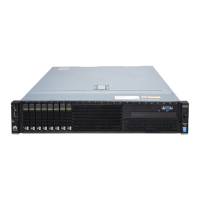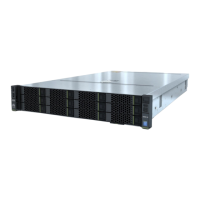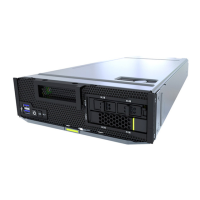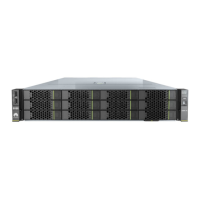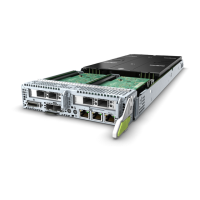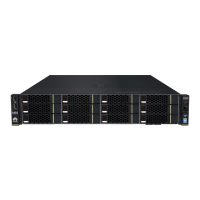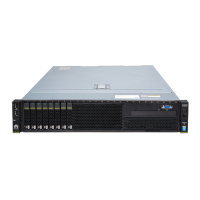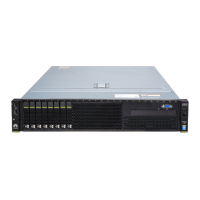Do you have a question about the Huawei FusionServer G5500 and is the answer not in the manual?
Illustrates the main physical components of the G5500 server chassis.
Identifies and shows components on the front panel of compute nodes like G560 and half-width nodes.
Explains the indicators and buttons on the front panels of full-width and half-width compute nodes.
Shows the components located on the rear panel of the server, including modules and PSUs.
Describes the indicators and ports on the server's rear panel, detailing their state descriptions.
Illustrates the numbering and location of hard disk slots on full-width and half-width compute nodes.
Displays the mainboard components for G560, GP608, G530 V2, and GP316 compute nodes.
Provides step-by-step instructions for powering off a compute node using the iBMC WebUI.
Details the procedures for powering on a compute node via the iBMC WebUI, considering PSU status.
Guides users on the correct procedure to remove a G560 compute node from the server chassis.
Explains how to safely remove a GP608 compute node, noting its dislocation design.
Provides instructions for removing a G530 V2 compute node, including handling specific configurations.
Outlines the procedure for safely removing a GP316 compute node from the server.
Describes how to remove and install the top cover for G560, GP608, G530 V2, and GP316 compute nodes.
Specifies environmental conditions, space, cabinet, and temperature/humidity requirements for server installation.
Details the process of installing the server chassis into a cabinet using guide rails and securing it.
Introduces installing optional components like GPUs, CPUs, and DIMMs for various compute nodes.
Covers the installation procedures for different compute nodes (GP608, G560, GP316, G530 V2) into the chassis.
Explains how to install an I/O module for external network connectivity.
Describes the internal cabling requirements, focusing on SAS and 8-pin power cables.
Outlines the initial configuration process for the G5500 server using a local PC.
Lists default user names, passwords, and IP addresses for management and compute modules.
Details the initial configuration process and procedures for the management module using a local PC.
Guides on configuring the installed G560 compute node to support upper-layer services.
Explains how to configure the installed G530 V2 compute node for upper-layer services.
Describes how to configure logical topologies for the G5500 server.
Provides essential precautions and safety warnings before installing optional components.
Details the installation of optional parts for the G560, including hard disks, CPUs, and DIMMs.
Covers the installation of optional parts for the GP608, such as hard disks and GPU cards.
Explains the installation of optional parts for the G530 V2, including hard disks, CPUs, and DIMMs.
Details the installation of optional parts for the GP316, such as riser card trays and PCIe cards.
Describes the process of installing a Power Supply Unit (PSU) into the server.
Guides on installing PCIe cards and I/O modules for server connectivity.
Covers the installation of the RTC battery and the management module.
Explains how to install a fan module for server cooling.
Explains the systematic approach to identifying and resolving server faults.
Discusses downloading and installing software and firmware packages for server maintenance.
Highlights proactive maintenance for detecting and rectifying potential server faults.
Describes Huawei's Intelligent Baseboard Management Controller (iBMC) and its remote management features.
Explains the role of the Basic Input/Output System (BIOS) in hardware initialization and configuration.
Details the functions of the management module for server management, power, and fan control.
Provides general and personal safety guidelines for installing and handling hardware, including ESD precautions.
Outlines the warranty terms, conditions, and available services for Huawei servers.
Explains how to prevent damage to electronic components from static electricity during handling.
Details grounding methods like wrist straps and conductive mats for safe handling.
Lists detailed specifications for G560, GP608, G530 V2, and GP316 compute nodes.
Provides specifications for Power Supply Units (PSUs), including power output and cable requirements.
Outlines environmental requirements like temperature, humidity, and altitude for server operation.
Lists physical and performance specifications for the G560 compute node.
Details physical and performance specifications for the GP608 compute node.
Lists physical and performance specifications for the G530 V2 compute node.
Details physical and performance specifications for the GP316 compute node.
Lists resources for server documentation, compatibility checkers, and maintenance information.
Points to resources like multimedia portals and assistants for server component configuration.
Guides on collecting troubleshooting information and making debugging preparations before contacting support.
Provides information on contacting Huawei technical support and details needed for fault reporting.
Lists necessary materials like boards, tools, and cables for debugging and contacting support.
Advises consulting guide documents for common problems before contacting support.
Explains how to access Huawei's technical support services and resources via their website.
Provides contact information for Huawei Technologies Co., Ltd., including offices and headquarters.
Provides a glossary of acronyms and abbreviations used throughout the document.
Illustrates the logical structure and interconnections of components within G560, GP608, G530 V2, and GP316.
Illustrates the main physical components of the G5500 server chassis.
Identifies and shows components on the front panel of compute nodes like G560 and half-width nodes.
Explains the indicators and buttons on the front panels of full-width and half-width compute nodes.
Shows the components located on the rear panel of the server, including modules and PSUs.
Describes the indicators and ports on the server's rear panel, detailing their state descriptions.
Illustrates the numbering and location of hard disk slots on full-width and half-width compute nodes.
Displays the mainboard components for G560, GP608, G530 V2, and GP316 compute nodes.
Provides step-by-step instructions for powering off a compute node using the iBMC WebUI.
Details the procedures for powering on a compute node via the iBMC WebUI, considering PSU status.
Guides users on the correct procedure to remove a G560 compute node from the server chassis.
Explains how to safely remove a GP608 compute node, noting its dislocation design.
Provides instructions for removing a G530 V2 compute node, including handling specific configurations.
Outlines the procedure for safely removing a GP316 compute node from the server.
Describes how to remove and install the top cover for G560, GP608, G530 V2, and GP316 compute nodes.
Specifies environmental conditions, space, cabinet, and temperature/humidity requirements for server installation.
Details the process of installing the server chassis into a cabinet using guide rails and securing it.
Introduces installing optional components like GPUs, CPUs, and DIMMs for various compute nodes.
Covers the installation procedures for different compute nodes (GP608, G560, GP316, G530 V2) into the chassis.
Explains how to install an I/O module for external network connectivity.
Describes the internal cabling requirements, focusing on SAS and 8-pin power cables.
Outlines the initial configuration process for the G5500 server using a local PC.
Lists default user names, passwords, and IP addresses for management and compute modules.
Details the initial configuration process and procedures for the management module using a local PC.
Guides on configuring the installed G560 compute node to support upper-layer services.
Explains how to configure the installed G530 V2 compute node for upper-layer services.
Describes how to configure logical topologies for the G5500 server.
Provides essential precautions and safety warnings before installing optional components.
Details the installation of optional parts for the G560, including hard disks, CPUs, and DIMMs.
Covers the installation of optional parts for the GP608, such as hard disks and GPU cards.
Explains the installation of optional parts for the G530 V2, including hard disks, CPUs, and DIMMs.
Details the installation of optional parts for the GP316, such as riser card trays and PCIe cards.
Describes the process of installing a Power Supply Unit (PSU) into the server.
Guides on installing PCIe cards and I/O modules for server connectivity.
Covers the installation of the RTC battery and the management module.
Explains how to install a fan module for server cooling.
Explains the systematic approach to identifying and resolving server faults.
Discusses downloading and installing software and firmware packages for server maintenance.
Highlights proactive maintenance for detecting and rectifying potential server faults.
Describes Huawei's Intelligent Baseboard Management Controller (iBMC) and its remote management features.
Explains the role of the Basic Input/Output System (BIOS) in hardware initialization and configuration.
Details the functions of the management module for server management, power, and fan control.
Provides general and personal safety guidelines for installing and handling hardware, including ESD precautions.
Outlines the warranty terms, conditions, and available services for Huawei servers.
Explains how to prevent damage to electronic components from static electricity during handling.
Details grounding methods like wrist straps and conductive mats for safe handling.
Lists detailed specifications for G560, GP608, G530 V2, and GP316 compute nodes.
Provides specifications for Power Supply Units (PSUs), including power output and cable requirements.
Outlines environmental requirements like temperature, humidity, and altitude for server operation.
Lists physical and performance specifications for the G560 compute node.
Details physical and performance specifications for the GP608 compute node.
Lists physical and performance specifications for the G530 V2 compute node.
Details physical and performance specifications for the GP316 compute node.
Lists resources for server documentation, compatibility checkers, and maintenance information.
Points to resources like multimedia portals and assistants for server component configuration.
Guides on collecting troubleshooting information and making debugging preparations before contacting support.
Provides information on contacting Huawei technical support and details needed for fault reporting.
Lists necessary materials like boards, tools, and cables for debugging and contacting support.
Advises consulting guide documents for common problems before contacting support.
Explains how to access Huawei's technical support services and resources via their website.
Provides contact information for Huawei Technologies Co., Ltd., including offices and headquarters.
Provides a glossary of acronyms and abbreviations used throughout the document.
Illustrates the logical structure and interconnections of components within G560, GP608, G530 V2, and GP316.
| Chassis type | Rack (4U) |
|---|---|
| Device class | - |
| Product color | Black |
| Number of fans | 6 fan(s) |
| Redundant fans support | Yes |
| AC input voltage | 110-240 V |
| 80 PLUS certification | 80 PLUS Platinum |
| Number of power supply units | 4 |
| Power supply unit (PSU) capacity | 2200 W |
| Storage drive capacity | - GB |
| Storage drives installed | No |
| Maximum supported storage capacity | - TB |
| USB 2.0 ports quantity | USB 2.0 ports have a data transmission speed of 480 Mbps, and are backwards compatible with USB 1.1 ports. You can connect all kinds of peripheral devices to them. |
| Depth | 790 mm |
|---|---|
| Width | 447 mm |
| Height | 175 mm |
